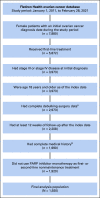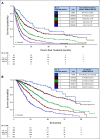Association of Multiple High-Risk Factors on Observed Outcomes in Real-World Patients With Advanced Ovarian Cancer Treated With First-Line Therapy
- PMID: 37294913
- PMCID: PMC10569783
- DOI: 10.1200/CCI.22.00189
Association of Multiple High-Risk Factors on Observed Outcomes in Real-World Patients With Advanced Ovarian Cancer Treated With First-Line Therapy
Abstract
Purpose: To identify risk factors for disease progression or death and assess outcomes by risk categories in real-world patients with advanced ovarian cancer.
Methods: This retrospective study included adult patients from a nationwide electronic health record-derived deidentified database with stage III/IV ovarian cancer who received first-line therapy and had ≥12 weeks of follow-up after index date (end of first-line therapy). Factors predictive of time to next treatment and overall survival (OS) were assessed. Patients were grouped according to the cumulative number of high-risk factors present (stage IV disease, no debulking surgery or neoadjuvant therapy and interval debulking surgery, visible residual disease after surgery, and breast cancer gene [BRCA] wild-type disease/unknown BRCA status), and time to next treatment and OS were assessed.
Results: Region of residence, disease stage, histology, BRCA status, surgery modality, and visible residual disease were significant predictors of time to next treatment; age, Eastern Cooperative Oncology Group performance status, disease stage, BRCA status, surgery modality, visible residual disease, and platelet levels were significant predictors of OS (N = 1,920). Overall, 96.4%, 74.1%, and 40.3% of patients had at least 1, 2, or 3 high-risk factors, respectively; 15.7% of patients had all four high-risk factors. Observed median time to next treatment was 26.4 months (95% CI, 17.1 to 49.2) in patients with no high-risk factors and 4.6 months (95% CI, 4.1 to 5.7) in patients with four high-risk factors. Observed median OS was shorter among patients with more high-risk factors.
Conclusion: These results underscore the complexity of risk assessment and demonstrate the importance of assessing a patient's cumulative risk profile rather than the impact of individual high-risk factors. They also highlight the potential for bias in cross-trial comparisons of median progression-free survival because of differences in risk-factor distribution among patient populations.
Conflict of interest statement
The following represents disclosure information provided by authors of this manuscript. All relationships are considered compensated unless otherwise noted. Relationships are self-held unless noted. I = Immediate Family Member, Inst = My Institution. Relationships may not relate to the subject matter of this manuscript. For more information about ASCO's conflict of interest policy, please refer to
Open Payments is a public database containing information reported by companies about payments made to US-licensed physicians (
No other potential conflicts of interest were reported.
Figures





Similar articles
-
Real-World Outcomes Following First-Line Treatment in Patients with Advanced Ovarian Cancer with Multiple Risk Factors for Disease Progression who Received Maintenance Therapy or Active Surveillance.Oncol Ther. 2023 Jun;11(2):245-261. doi: 10.1007/s40487-023-00227-6. Epub 2023 Apr 4. Oncol Ther. 2023. PMID: 37016186 Free PMC article.
-
BRCA mutational status, initial disease presentation, and clinical outcome in high-grade serous advanced ovarian cancer: a multicenter study.Am J Obstet Gynecol. 2017 Sep;217(3):334.e1-334.e9. doi: 10.1016/j.ajog.2017.05.036. Epub 2017 May 23. Am J Obstet Gynecol. 2017. PMID: 28549976
-
Real-life data on treatment and outcomes in advanced ovarian cancer: An observational, multinational cohort study (RESPONSE trial).Cancer. 2022 Aug 15;128(16):3080-3089. doi: 10.1002/cncr.34350. Epub 2022 Jun 17. Cancer. 2022. PMID: 35714310 Free PMC article.
-
Uptake and Outcomes of Neoadjuvant Chemotherapy Among US Patients With Less Common Epithelial Ovarian Carcinomas.JAMA Netw Open. 2023 Jun 1;6(6):e2318602. doi: 10.1001/jamanetworkopen.2023.18602. JAMA Netw Open. 2023. PMID: 37326992 Free PMC article.
-
Chemotherapy versus surgery for initial treatment in advanced ovarian epithelial cancer.Cochrane Database Syst Rev. 2021 Feb 5;2(2):CD005343. doi: 10.1002/14651858.CD005343.pub5. Cochrane Database Syst Rev. 2021. Update in: Cochrane Database Syst Rev. 2021 Jul 30;7:CD005343. doi: 10.1002/14651858.CD005343.pub6. PMID: 33543776 Free PMC article. Updated.
Cited by
-
Niraparib first-line maintenance therapy in patients with newly diagnosed advanced ovarian cancer: final overall survival results from the PRIMA/ENGOT-OV26/GOG-3012 trial.Ann Oncol. 2024 Nov;35(11):981-992. doi: 10.1016/j.annonc.2024.08.2241. Epub 2024 Sep 14. Ann Oncol. 2024. PMID: 39284381 Clinical Trial.
-
MiR-223-3p in Cancer Development and Cancer Drug Resistance: Same Coin, Different Faces.Int J Mol Sci. 2024 Jul 26;25(15):8191. doi: 10.3390/ijms25158191. Int J Mol Sci. 2024. PMID: 39125761 Free PMC article. Review.
-
Ovarian Cancer Retrospective European (O'CaRE) study: first-line outcomes by number of risk factors for progression.Future Oncol. 2024 Dec;20(40):3409-3419. doi: 10.1080/14796694.2024.2402217. Epub 2024 Oct 24. Future Oncol. 2024. PMID: 39445504 Free PMC article.
-
Prescribers and patients drive maintenance therapy patterns in a community oncology practice: National guidelines versus the real-world experience.Gynecol Oncol Rep. 2024 Jun 25;54:101440. doi: 10.1016/j.gore.2024.101440. eCollection 2024 Aug. Gynecol Oncol Rep. 2024. PMID: 39040942 Free PMC article.
-
Real-world post-2020 first-line maintenance treatment patterns in patients with advanced ovarian cancer in the US.Future Oncol. 2025 Aug;21(19):2495-2503. doi: 10.1080/14796694.2025.2526273. Epub 2025 Jul 14. Future Oncol. 2025. PMID: 40654327 Free PMC article.
References
-
- Siegel RL, Miller KD, Fuchs HE, et al. : Cancer statistics, 2021. CA Cancer J Clin 71:7-33, 2021 - PubMed
-
- PDQ Adult Treatment Editorial Board : Ovarian Epithelial, Fallopian Tube, and Primary Peritoneal Cancer Treatment (PDQ®): Health Professional Version, in PDQ Cancer Information Summaries. Bethesda (MD), National Cancer Institute (US), 2021 - PubMed
Publication types
MeSH terms
LinkOut - more resources
Full Text Sources
Medical

